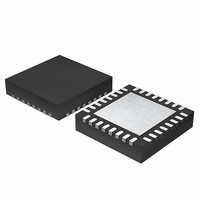EFM32G200F64 Energy Micro, EFM32G200F64 Datasheet - Page 93

EFM32G200F64
Manufacturer Part Number
EFM32G200F64
Description
MCU 32BIT 64KB FLASH 32-QFN
Manufacturer
Energy Micro
Series
Geckor
Datasheets
1.EFM32G200F16.pdf
(63 pages)
2.EFM32G200F16.pdf
(10 pages)
3.EFM32G200F16.pdf
(463 pages)
4.EFM32G200F16.pdf
(136 pages)
Specifications of EFM32G200F64
Core Processor
ARM® Cortex-M3™
Core Size
32-Bit
Speed
32MHz
Connectivity
EBI/EMI, I²C, IrDA, SmartCard, SPI, UART/USART
Peripherals
Brown-out Detect/Reset, DMA, POR, PWM, WDT
Number Of I /o
24
Program Memory Size
64KB (64K x 8)
Program Memory Type
FLASH
Ram Size
16K x 8
Voltage - Supply (vcc/vdd)
1.8 V ~ 3.8 V
Data Converters
A/D 4x12b, D/A 1x12b
Oscillator Type
External
Operating Temperature
-40°C ~ 85°C
Package / Case
32-VQFN Exposed Pad
Processor Series
EFM32G200
Core
ARM Cortex-M3
Data Bus Width
32 bit
Data Ram Size
16 KB
Interface Type
I2C, UART
Maximum Clock Frequency
32 MHz
Number Of Programmable I/os
24
Number Of Timers
2
Operating Supply Voltage
1.8 V to 3.8 V
Maximum Operating Temperature
+ 85 C
Mounting Style
SMD/SMT
Minimum Operating Temperature
- 40 C
Lead Free Status / RoHS Status
Lead free / RoHS Compliant
Eeprom Size
-
Lead Free Status / Rohs Status
Details
Available stocks
Company
Part Number
Manufacturer
Quantity
Price
4.2.8 Software Trigger Interrupt Register
4.2.9 Level-sensitive interrupts
4.2.9.1 Hardware and software control of interrupts
2011-02-04 - d0002_Rev1.00
Write to the STIR to generate a Software Generated Interrupt (SGI). See the register summary in
Table 4.2 (p. 88) for the STIR attributes.
When the USERSETMPEND bit in the SCR is set to 1, unprivileged software can access the STIR, see
Section 4.3.7 (p. 100) .
Note
The bit assignments are:
Table 4.10. STIR bit assignments
All interrupt lines in the EFM32 devices are level sensitive interrupts. A level-sensitive interrupt is held
asserted until the peripheral deasserts the interrupt signal. Typically this happens because the ISR
accesses the peripheral, causing it to clear the interrupt request.
When the processor enters the ISR, it automatically removes the pending state from the interrupt, see
Section 4.2.9.1 (p. 93) . If the signal is not deasserted before the processor returns from the ISR, the
interrupt becomes pending again, and the processor must execute its ISR again. This means that the
peripheral can hold the interrupt signal asserted until it no longer needs servicing.
The Cortex-M3 latches all interrupts. A peripheral interrupt becomes pending for one of the following
reasons:
• the NVIC detects that the interrupt signal is HIGH and the interrupt is not active
• the NVIC detects a rising edge on the interrupt signal
• software writes to the corresponding interrupt set-pending register bit, see Section 4.2.4 (p. 90) ,
A pending interrupt remains pending until one of the following:
• The processor enters the ISR for the interrupt. This changes the state of the interrupt from pending
• Software writes to the corresponding interrupt clear-pending register bit.
31
Bits
[31:9]
[8:0]
• byte offset 2 refers to register bits[23:16]
• byte offset 3 refers to register bits[31:24].
or to the STIR to make an SGI pending, see Section 4.2.8 (p. 93) .
to active. Then:
• When the processor returns from the ISR, the NVIC samples the interrupt signal. If the signal
is asserted, the state of the interrupt changes to pending, which might cause the processor to
immediately re-enter the ISR. Otherwise, the state of the interrupt changes to inactive.
Field
-
INTID
Only privileged software can enable unprivileged access to the STIR.
Function
Reserved.
Interrupt ID of the required SGI, in the range 0 to (n-1), where n denotes the number of interrupts given
by Table 1.1 (p. 5) . For example, a value of b000000011 specifies interrupt IRQ3.
Reserved
...the world's most energy friendly microcontrollers
93
9
8
www.energymicro.com
INTID
0


















